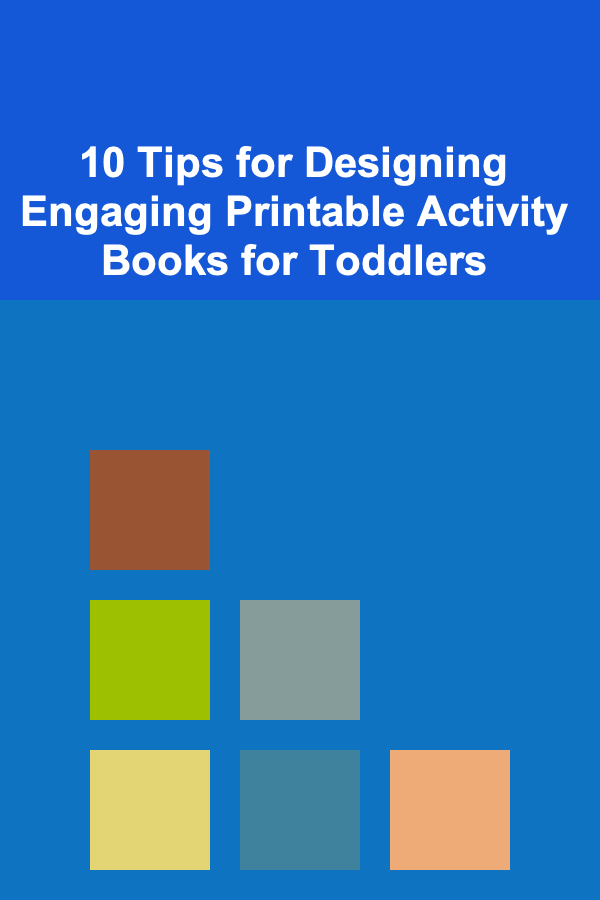
10 Tips for Designing Engaging Printable Activity Books for Toddlers
ebook include PDF & Audio bundle (Micro Guide)
$12.99$9.99
Limited Time Offer! Order within the next:

Designing printable activity books for toddlers can be a rewarding yet challenging endeavor. Toddlers are curious, energetic, and full of imagination, but they also have short attention spans and very specific learning needs. Therefore, creating engaging content that keeps them entertained, educates them, and fosters their development requires careful consideration of both design and content.
In this article, we will explore 10 essential tips for designing printable activity books that not only captivate toddlers but also provide them with valuable learning opportunities. These tips will help you create a resource that encourages creativity, supports motor skills, and enhances cognitive development, all while ensuring that it remains fun and engaging for young children.
Use Simple and Bold Visuals
Why Simple Visuals Matter
Toddlers are still developing their visual perception and recognition skills, which means that overly complicated images or too much detail can overwhelm them. Instead, focus on using simple, bold visuals that are easy to understand and engaging.
How to Apply This
- Use Large, Clear Shapes: Avoid intricate designs and use basic shapes that are easy for toddlers to recognize, such as circles, squares, and triangles.
- Bold Colors: Bright, vibrant colors capture a toddler's attention and stimulate visual learning. Stick to high-contrast color combinations, like blue and yellow, red and green, which are visually appealing and easy for toddlers to differentiate.
- Minimalist Approach: Keep backgrounds simple and free of unnecessary elements. A clean, uncluttered design helps the child focus on the activity itself.
Prioritize Interactive Activities
Why Interactivity Is Key
Interactive activities engage a toddler's mind and body. At this stage of development, children are highly tactile and are learning by doing. Activities that allow them to participate physically, such as drawing, coloring, or tracing, not only hold their attention but also help them practice essential motor skills.
How to Apply This
- Coloring Pages: Include large, bold illustrations that toddlers can color in. This simple activity promotes creativity and fine motor skills.
- Tracing Activities: Provide dotted lines that toddlers can trace, helping to develop hand-eye coordination and pencil control.
- Cutting and Pasting: Activities that involve cutting out shapes or stickers (with parental supervision) provide opportunities for hands-on learning and help toddlers refine their fine motor skills.
Incorporate Educational Themes
Why Education Matters
Toddlers are in a critical stage of early learning, and activity books provide a great opportunity to introduce them to important educational concepts. Whether it's numbers, letters, animals, shapes, or colors, you can use your activity book to introduce and reinforce these concepts in a fun and interactive way.
How to Apply This
- ABC and Number Activities: Include pages that help toddlers learn the alphabet and numbers, such as matching games, letter tracing, or counting exercises.
- Animal Recognition: Include simple activities where toddlers can match animals with their sounds or habitats. This not only helps them learn animal names but also understand basic concepts of the natural world.
- Shape and Color Recognition: Design activities that focus on shape and color identification. For example, activities where toddlers match colored objects with their corresponding shapes.
Focus on Age-Appropriate Complexity
Why Age-Appropriate Design Matters
While toddlers are eager to explore and learn, their cognitive and physical abilities are still developing. It's important to design activities that are challenging but not too difficult, as frustration can cause toddlers to lose interest.
How to Apply This
- Simple Instructions: Keep the instructions short and straightforward. Use minimal text, as toddlers may not yet be able to read. Instead, use visual cues and illustrations to explain the activity.
- Gradual Progression: Start with very basic activities, such as simple coloring or shape-matching, and gradually increase the complexity as the child progresses.
- Avoid Overcrowding Pages: Don't overload each page with too many tasks or items. A single, focused activity per page is ideal.
Make It Visually Stimulating
Why Visual Stimulation Is Important
At this stage, toddlers are incredibly receptive to visual stimulation, and the right design can foster their creativity and problem-solving skills. Bold, eye-catching illustrations and designs will keep them engaged and encourage them to interact with the book.
How to Apply This
- Engaging Illustrations: Include characters or animals that toddlers can easily connect with. For example, animal-themed pages are often a hit because they are both visually appealing and educational.
- Dynamic Layouts: Experiment with layouts that encourage exploration. For instance, create pages where elements move across the page or incorporate playful elements like arrows to guide them through the activity.
Incorporate Storytelling Elements
Why Storytelling Helps
Toddlers love stories, and incorporating storytelling elements into your activity book can significantly enhance engagement. Even though toddlers may not fully understand long stories, they enjoy looking at pictures and hearing about the characters and adventures.
How to Apply This
- Simple Storylines: Include pages where toddlers can follow a simple narrative, such as a story about a bear finding food or a cat exploring a garden. Keep the story elements simple and engaging.
- Picture Stories: Use picture-based storytelling where toddlers can match pictures to complete the story. This could involve a sequence of images that they need to arrange in order or a 'spot the difference' activity.
- Character-Centric Activities: Create activities that follow the adventures of a favorite character. Children may find it easier to connect with and enjoy activities if a character is involved.
Provide Opportunities for Sensory Exploration
Why Sensory Exploration is Essential
At this age, toddlers are still learning about the world through their senses. By providing activities that engage their senses---touch, sight, and sometimes even smell or taste---you help them explore and understand their environment.
How to Apply This
- Textured Materials: While this is primarily relevant for physical activity books, consider adding textures to your printable book by including patterns that toddlers can trace or feel (e.g., lines, bumps, or smooth surfaces they can rub with their hands).
- Cut-and-Paste Projects: Toddlers can develop tactile skills by cutting out different shapes or objects and gluing them onto other parts of the page.
- Sensory Themes: Introduce sensory-themed activities, such as asking the child to "color the sand" or "paint the ocean," where they can associate textures and feelings with their tasks.
Keep the Pages Fun and Playful
Why Fun is a Must
Toddlers are not going to engage with an activity if it feels too much like work. Keep the atmosphere light and playful, and encourage laughter and enjoyment through your designs. The goal is not only to educate but also to ensure that the activity book is enjoyable.
How to Apply This
- Playful Characters: Include friendly, approachable characters that toddlers can bond with. Bright animal faces, silly shapes, or fun monsters make activities feel like an exciting adventure.
- Incorporate Games and Challenges: Simple games such as mazes, matching, or dot-to-dot puzzles can be incorporated. These activities feel more like play than structured learning, which toddlers love.
- Surprise Elements: Add elements of surprise to some pages, such as "pop-out" sections or hidden objects. This keeps the child curious and excited to explore the entire book.
Consider Print-Readiness
Why Print-Readiness Matters
Since the activity book is intended to be printed, consider the paper type and how the designs will translate from screen to print. Ensure that your designs are optimized for printing, especially considering the level of detail that will be visible on the printed page.
How to Apply This
- High-Resolution Images: Use high-quality, high-resolution images to ensure that the printed pages are clear and crisp. Avoid pixelation or blurry visuals.
- Color Considerations: Keep in mind that colors may appear differently when printed, especially on various types of printers. Test print a few pages to ensure that the colors are vibrant and true to the digital design.
- Clear, Simple Layout: Since toddlers are unlikely to handle a printed book gently, ensure that the design is easy to print and doesn't require intricate cutting or special paper. Use simple borders, clean lines, and enough space around the images to prevent overcrowding.
Focus on Parent and Child Interaction
Why Parent and Child Engagement Matters
While toddlers are the primary audience, activity books also serve as an excellent bonding opportunity for parents and children. Including activities that encourage parent-child interaction not only fosters learning but also strengthens emotional connections.
How to Apply This
- Guidance for Parents: Include tips and instructions for parents on how to assist their child with the activities. This could include suggestions on how to ask questions, promote learning, or engage in discussions related to the activity.
- Collaborative Activities: Design activities where both parent and child can work together, such as joint coloring, storytelling, or solving simple puzzles.
- Reflective Prompts: Provide spaces for parents to write short reflections or notes about their child's progress, which encourages meaningful conversation and participation.
Designing engaging printable activity books for toddlers requires a blend of creativity, educational insight, and a deep understanding of child development. By following these 10 tips, you can create an activity book that not only entertains toddlers but also supports their cognitive, emotional, and physical growth. With a focus on simplicity, fun, and interactivity, your printable activity book will provide both toddlers and their parents with hours of enjoyable and educational experiences.
Reading More From Our Other Websites
- [Needle Felting Tip 101] Creative Project Ideas: What to Make With Your New Needle Felting Kit
- [Organization Tip 101] How to Manage Event Logistics for a Seamless Experience
- [Personal Financial Planning 101] How to Save for Your Child's College Education
- [Home Soundproofing 101] How to Soundproof Your Home for a Peaceful Living Environment
- [Home Budget 101] How to Budget for Furniture Replacement & Upgrades
- [Organization Tip 101] How to Make the Most of Limited Closet Space Together
- [Personal Care Tips 101] How to Prevent Over-Exfoliation with a Gentle Facial Scrub
- [Organization Tip 101] How to Add Warmth and Personality to a Scandinavian Living Room
- [Home Security 101] How to Upgrade Your Door Lock Cylinder for Stronger Home Security
- [Simple Life Tip 101] Best No‑Screen Evening Rituals to Unwind and Embrace Simplicity

How to Stage Outdoor Areas for Year-Round Appeal
Read More
How to Use Email Marketing to Make Money
Read More
How To Understand the Genetics of Drug Metabolism
Read More
How To Reduce Your Alcohol Consumption for Health
Read More
How To Choose the Best Eyeshadow Palette for Your Eye Color
Read More
Analyzing Character Development in Film
Read MoreOther Products

How to Stage Outdoor Areas for Year-Round Appeal
Read More
How to Use Email Marketing to Make Money
Read More
How To Understand the Genetics of Drug Metabolism
Read More
How To Reduce Your Alcohol Consumption for Health
Read More
How To Choose the Best Eyeshadow Palette for Your Eye Color
Read More